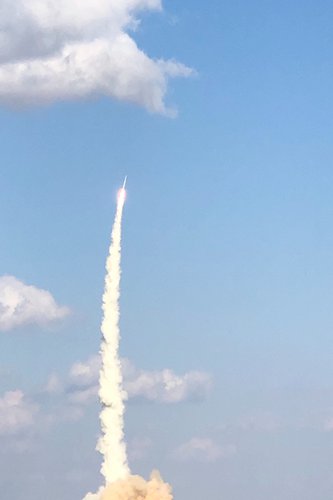Chinese commercial rocket firm fails in orbital launch attempt due to malfunction of rate gyroscope

OneSpace's OS-M rocket was launched at 5:39 pm on March 27, but failed to send a satellite to the orbit due to the malfunction of its rate gyroscope. Photo: Zhang Dan/GT
Chinese commercial rocket pioneer OneSpace Technology on March 27 failed to send a satellite into orbit at the Jiuquan Satellite Launch Center in Northwest China's Gansu Province due to the malfunction of the OS-M rocket's rate gyroscope, the company announced on Monday.The rocket took off at 5:39 pm, but an abnormality occurred at the rocket's rate gyroscope, which failed to identify the rocket's position and direction. As a result, after 45.68 seconds, the rocket followed a twisting trajectory.
Industry analysts told the Global Times the rate gyroscope functions like the "eye" of the rocket.
"As a core technology of China's national rocket team, the research and development of the rate gyroscope also encountered similar problems as OneSpace," Huang Zhicheng, an expert in space technology, told the Global Times on Tuesday, adding that the national team also spent years tackling difficulties related to rate gyroscopes.
Now, the national team's rate gyroscope has developed to a mature stage, according to Huang. For example, its factory that produces rate gyroscopes requires a high level of cleanliness and accuracy, but commercial rate gyroscope manufacturers may not reach this standard, Huang said.
The national team has more advanced technology and manufacturing resources for the rate gyroscope than private rocket makers, leaving the latter bigger challenges to tackle in the future, he added.
He also noted the OS-M rocket is long and slender, which may cause vibration in the rate gyroscope more easily, but a more detailed explanation will be announced by OneSpace.
"The failure won't change future launch plans of OneSpace in 2019," Shu Chang, CEO of OneSpace, told the Global Times after the launch. He noted there will be another two to three OS-X series rocket launches and maybe another OS-M rocket launch this year.
The OS-M rocket "Chongqing Liangjiang Star" is 90-percent designed and developed by Chongqing-based start-up company OneSpace.
The four-stage solid propellant rocket is 19 meters in length, 1.2 meters in diameter and has a takeoff weight of 21 tons. Unlike the two previously launched rockets of the OS-X series in May and September, the OS-M is capable of delivering maximum payloads of 100 kilograms into a 500-kilometer sun-synchronous orbit.
Within the past two years, OneSpace has carried out 47 major tests in order to resolve core technologies and difficulties of the rocket engine and integral control machine.
The 10-kilogram satellite "ZG6U-1B" was developed by private nano-satellite manufacturer Beijing ZeroG Space Technology Co (also called ZeroG Lab) with a cost of about $1 million.
Zhang Bei, the Co-founder of ZeroG Lab, told the Global Times the rocket's failure is understandable and the company has insured its satellite. "We still have confidence in China's commercial rocket makers, and in April, iSpace will take another of our satellites to space," he said.
Comparing Chinese commercial rocket companies with those of the US, Zhang said the US rocket market has better commercialization because of its resources and talent. "We should leave time for China's commercial rocket companies," he noted.
Huang told the Global Times that the domestic private rocket sector is still at an early development phase, but it has achieved a lot during the past three years of development.
"The failure of OneSpace to send its OS-M rocket into orbit does not dent the growing momentum of the nation's nascent private-sector commercial rocket launches," said Huang, adding the launch attempt has laid the foundation for future success as the technology has been tested.
He also suggested that Chinese private rocket firms should develop at their own pace instead of racing against each other or pursuing success. "The space sector contains high risks, and also calls for huge investment," said Huang.
In October, another private rocket start-up, Land Space Technology Co, launched its first rocket carrying a small satellite for state broadcaster China Media Group at the Jiuquan Satellite Launch Center. The rocket's first and second stages were successful, but an abnormality occurred during the third stage, and the cargo failed to reach its target orbit.
In 2014, the State Council, China's cabinet, issued a directive encouraging private capital to participate in the research, production and launch services for commercial satellites, a move that opened doors for the private commercial space sector in China.


